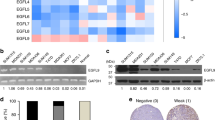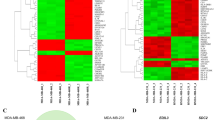Abstract
Epithelial-to-mesenchymal transition (EMT) promotes cell motility, which is important for the metastasis of malignant cells, and blocks CD95-mediated apoptotic signaling triggered by immune cells and chemotherapeutic regimens. CD95L, the cognate ligand of CD95, can be cleaved by metalloproteases and released as a soluble molecule (cl-CD95L). Unlike transmembrane CD95L, cl-CD95L does not induce apoptosis but triggers cell motility. Electron paramagnetic resonance was used to show that EMT and cl-CD95L treatment both led to augmentation of plasma membrane fluidity that was instrumental in inducing cell migration. Compaction of the plasma membrane is modulated, among other factors, by the ratio of certain lipids such as sphingolipids in the membrane. An integrative analysis of gene expression in NCI tumor cell lines revealed that expression of ceramide synthase-6 (CerS6) decreased during EMT. Furthermore, pharmacological and genetic approaches established that modulation of CerS6 expression/activity in cancer cells altered the level of C16-ceramide, which in turn influenced plasma membrane fluidity and cell motility. Therefore, this study identifies CerS6 as a novel EMT-regulated gene that has a pivotal role in the regulation of cell migration.
This is a preview of subscription content, access via your institution
Access options
Subscribe to this journal
Receive 50 print issues and online access
$259.00 per year
only $5.18 per issue
Buy this article
- Purchase on Springer Link
- Instant access to full article PDF
Prices may be subject to local taxes which are calculated during checkout





Similar content being viewed by others
References
Strasser A, Jost PJ, Nagata S . The many roles of FAS receptor signaling in the immune system. Immunity 2009; 30: 180–192.
Hoogwater FJ, Nijkamp MW, Smakman N, Steller EJ, Emmink BL, Westendorp BF et al. Oncogenic K-Ras turns death receptors into metastasis-promoting receptors in human and mouse colorectal cancer cells. Gastroenterology 2010; 138: 2357–2367.
Kleber S, Sancho-Martinez I, Wiestler B, Beisel A, Gieffers C, Hill O et al. Yes and PI3K bind CD95 to signal invasion of glioblastoma. Cancer Cell 2008; 13: 235–248.
Tauzin S, Chaigne-Delalande B, Selva E, Khadra N, Daburon S, Contin-Bordes C et al. The naturally processed CD95L elicits a c-yes/calcium/PI3K-driven cell migration pathway. PLoS Biol 2011; 9: e1001090.
O' Reilly LA, Tai L, Lee L, Kruse EA, Grabow S, Fairlie WD et al. Membrane-bound Fas ligand only is essential for Fas-induced apoptosis. Nature 2009; 461: 659–663.
Kischkel FC, Hellbardt S, Behrmann I, Germer M, Pawlita M, Krammer PH et al. Cytotoxicity-dependent APO-1 (Fas/CD95)-associated proteins form a death-inducing signaling complex (DISC) with the receptor. EMBO J 1995; 14: 5579–5588.
Algeciras-Schimnich A, Pietras EM, Barnhart BC, Legembre P, Vijayan S, Holbeck SL et al. Two CD95 tumor classes with different sensitivities to antitumor drugs. Proc Natl Acad Sci USA 2003; 100: 11445–11450.
Hannun YA, Obeid LM . Principles of bioactive lipid signalling: lessons from sphingolipids. Nat Rev Mol Cell Biol 2008; 9: 139–150.
Mullen TD, Hannun YA, Obeid LM . Ceramide synthases at the centre of sphingolipid metabolism and biology. Biochem J 2012; 441: 789–802.
Weinmann A, Galle PR, Teufel A . LASS6, an additional member of the longevity assurance gene family. Int J Mol Med 2005; 16: 905–910.
Silva LC, de Almeida RF, Castro BM, Fedorov A, Prieto M . Ceramide-domain formation and collapse in lipid rafts: membrane reorganization by an apoptotic lipid. Biophys J 2007; 92: 502–516.
Goni FM, Alonso A . Effects of ceramide and other simple sphingolipids on membrane lateral structure. Biochim Biophys Acta 2009; 1788: 169–177.
Gulbins E, Dreschers S, Wilker B, Grassme H . Ceramide, membrane rafts and infections. J Mol Med 2004; 82: 357–363.
Silva LC, Ben David O, Pewzner-Jung Y, Laviad EL, Stiban J, Bandyopadhyay S et al. Ablation of ceramide synthase 2 strongly affects biophysical properties of membranes. J Lipid Res 2012; 53: 430–436.
Pewzner-Jung Y, Park H, Laviad EL, Silva LC, Lahiri S, Stiban J et al. A critical role for ceramide synthase 2 in liver homeostasis: I. alterations in lipid metabolic pathways. J Biol Chem 2010; 285: 10902–10910.
Nakazawa I, Iwaizumi M . A role of the cancer cell membrane fluidity in the cancer metastases: an ESR study. Tohoku J Exp Med 1989; 157: 193–198.
Sok M, Sentjurc M, Schara M, Stare J, Rott T . Cell membrane fluidity and prognosis of lung cancer. Ann Thorac Surg 2002; 73: 1567–1571.
Taraboletti G, Perin L, Bottazzi B, Mantovani A, Giavazzi R, Salmona M . Membrane fluidity affects tumor-cell motility, invasion and lung-colonizing potential. Int J Cancer 1989; 44: 707–713.
Zeisig R, Koklic T, Wiesner B, Fichtner I, Sentjurc M . Increase in fluidity in the membrane of MT3 breast cancer cells correlates with enhanced cell adhesion in vitro and increased lung metastasis in NOD/SCID mice. Arch Biochem Biophys 2007; 459: 98–106.
Alonso A, Meirelles NC, Tabak M . Effect of hydration upon the fluidity of intercellular membranes of stratum corneum: an EPR study. Biochim Biophys Acta 1995; 1237: 6–15.
Luciano L, Konitz H, Reale E . Localization of cholesterol in the colonic epithelium of the guinea pig: regional differences and functional implications. Cell Tissue Res 1989; 258: 339–347.
Vlasic N, Medow MS, Schwarz SM, Pritchard Jr. KA, Stemerman MB . Lipid fluidity modulates platelet aggregation and agglutination in vitro. Life Sci 1993; 53: 1053–1060.
Ross DT, Scherf U, Eisen MB, Perou CM, Rees C, Spellman P et al. Systematic variation in gene expression patterns in human cancer cell lines. Nat Genet 2000; 24: 227–235.
Park SM, Gaur AB, Lengyel E, Peter ME . The miR-200 family determines the epithelial phenotype of cancer cells by targeting the E-cadherin repressors ZEB1 and ZEB2. Genes Dev 2008; 22: 894–907.
Elenbaas B, Spirio L, Koerner F, Fleming MD, Zimonjic DB, Donaher JL et al. Human breast cancer cells generated by oncogenic transformation of primary mammary epithelial cells. Genes Dev 2001; 15: 50–65.
Hahn WC, Dessain SK, Brooks MW, King JE, Elenbaas B, Sabatini DM et al. Enumeration of the simian virus 40 early region elements necessary for human cell transformation. Mol Cell Biol 2002; 22: 2111–2123.
Morel AP, Lievre M, Thomas C, Hinkal G, Ansieau S, Puisieux A . Generation of breast cancer stem cells through epithelial-mesenchymal transition. PLoS One 2008; 3: e2888.
Hesling C, Fattet L, Teyre G, Jury D, Gonzalo P, Lopez J et al. Antagonistic regulation of EMT by TIF1gamma and Smad4 in mammary epithelial cells. EMBO Rep 2011; 12: 665–672.
Sorlie T, Perou CM, Tibshirani R, Aas T, Geisler S, Johnsen H et al. Gene expression patterns of breast carcinomas distinguish tumor subclasses with clinical implications. Proc Natl Acad Sci USA 2001; 98: 10869–10874.
Sarrio D, Rodriguez-Pinilla SM, Hardisson D, Cano A, Moreno-Bueno G, Palacios J . Epithelial-mesenchymal transition in breast cancer relates to the basal-like phenotype. Cancer Res 2008; 68: 989–997.
Jezequel P, Frenel JS, Campion L, Guerin-Charbonnel C, Gouraud W, Ricolleau G et al. bc-GenExMiner 3.0: new mining module computes breast cancer gene expression correlation analyses. Database (Oxford) 2013; 2013: bas060.
Wang E, Norred WP, Bacon CW, Riley RT, Merrill Jr. AH . Inhibition of sphingolipid biosynthesis by fumonisins. Implications for diseases associated with Fusarium moniliforme. J Biol Chem 1991; 266: 14486–14490.
Guan F, Handa K, Hakomori SI . Specific glycosphingolipids mediate epithelial-to-mesenchymal transition of human and mouse epithelial cell lines. Proc Natl Acad Sci USA 2009; 106: 7461–7466.
Asano S, Kitatani K, Taniguchi M, Hashimoto M, Zama K, Mitsutake S et al. Regulation of cell migration by sphingomyelin synthases: sphingomyelin in lipid rafts decreases responsiveness to signaling by the CXCL12/CXCR4 pathway. Mol Cell Biol 2012; 32: 3242–3252.
Hanai N, Dohi T, Nores GA, Hakomori S . A novel ganglioside, de-N-acetyl-GM3 (II3NeuNH2LacCer), acting as a strong promoter for epidermal growth factor receptor kinase and as a stimulator for cell growth. J Biol Chem 1988; 263: 6296–6301.
Mutoh T, Tokuda A, Miyadai T, Hamaguchi M, Fujiki N . Ganglioside GM1 binds to the Trk protein and regulates receptor function. Proc Natl Acad Sci USA 1995; 92: 5087–5091.
Malleter M, Tauzin S, Bessede A, Castellano R, Goubard A, Godey F et al. CD95L cell surface cleavage triggers a prometastatic signaling pathway in triple-negative breast cancer. Cancer Res 2013; 73: 6711–6721.
Xu L, Deng X . Suppression of cancer cell migration and invasion by protein phosphatase 2A through dephosphorylation of mu- and m-calpains. J Biol Chem 2006; 281: 35567–35575.
Konishi H, Karakas B, Abukhdeir AM, Lauring J, Gustin JP, Garay JP et al. Knock-in of mutant K-ras in nontumorigenic human epithelial cells as a new model for studying K-ras mediated transformation. Cancer Res 2007; 67: 8460–8467.
Sergent O, Tomasi A, Ceccarelli D, Masini A, Nohl H, Cillard P et al. Combination of iron overload plus ethanol and ischemia alone give rise to the same endogenous free iron pool. Biometals 2005; 18: 567–575.
Acknowledgements
We are grateful to the L3 and microscopy facilities of the SFR Biosit (Université de Rennes-1, Rennes, France) for their technical assistance. We thank Nicole Therville and Julia Rochotte for their technical assistance. We also acknowledge the assistance of Dr Pauline Le Faouder and Dr Justine Bertrand-Michel from the lipidomic facilities (INSERM U1048, Toulouse, France). This work was supported by grants from the French Government managed by the French National Research Agency (ANR) and under the program ‘Investissements d’Avenir’ with reference ANR-11-LABX-0021-01-LipSTIC Labex, INCa, ARC, Cancéropole Grand Ouest, Région Bretagne, Région Bourgogne, Rennes Métropole, Ligue Contre le Cancer (Comités d’Ille-et-Vilaine/du Morbihan/des Côtes d’Armor/du Maine et Loire et les comités du Doubs/de l'Yonne), Conseil Général d'Ille-et-Vilaine, project Membratox (Grant number 32508) and the European union (FEDER).
Author information
Authors and Affiliations
Corresponding author
Ethics declarations
Competing interests
The authors declare no conflict of interest.
Additional information
Supplementary Information accompanies this paper on the Oncogene website
Rights and permissions
About this article
Cite this article
Edmond, V., Dufour, F., Poiroux, G. et al. Downregulation of ceramide synthase-6 during epithelial-to-mesenchymal transition reduces plasma membrane fluidity and cancer cell motility. Oncogene 34, 996–1005 (2015). https://doi.org/10.1038/onc.2014.55
Received:
Revised:
Accepted:
Published:
Issue Date:
DOI: https://doi.org/10.1038/onc.2014.55
This article is cited by
-
Multifractal analysis of cellular ATR-FTIR spectrum as a method for identifying and quantifying cancer cell metastatic levels
Scientific Reports (2023)
-
p140Cap modulates the mevalonate pathway decreasing cell migration and enhancing drug sensitivity in breast cancer cells
Cell Death & Disease (2023)
-
The epithelial–mesenchymal plasticity landscape: principles of design and mechanisms of regulation
Nature Reviews Genetics (2023)
-
Involvement of cell shape and lipid metabolism in glioblastoma resistance to temozolomide
Acta Pharmacologica Sinica (2023)
-
Biophysics in tumor growth and progression: from single mechano-sensitive molecules to mechanomedicine
Oncogene (2023)



